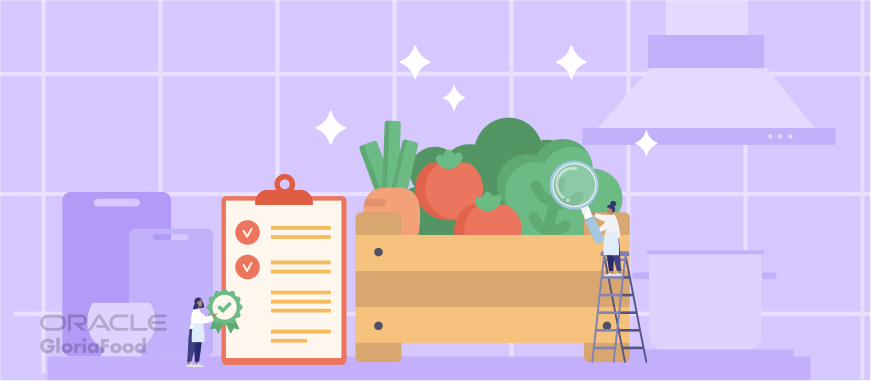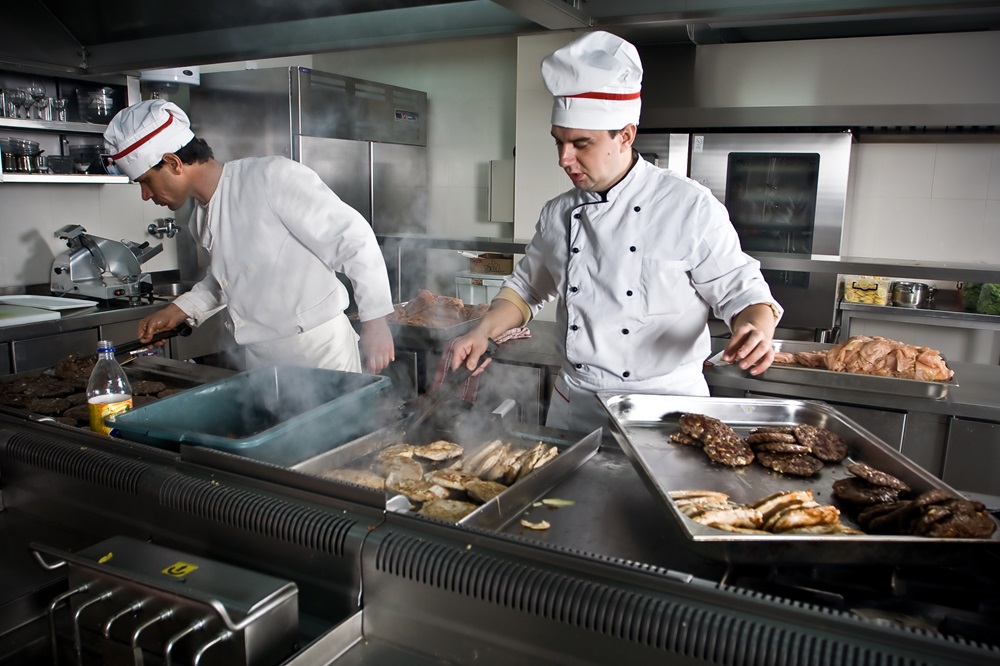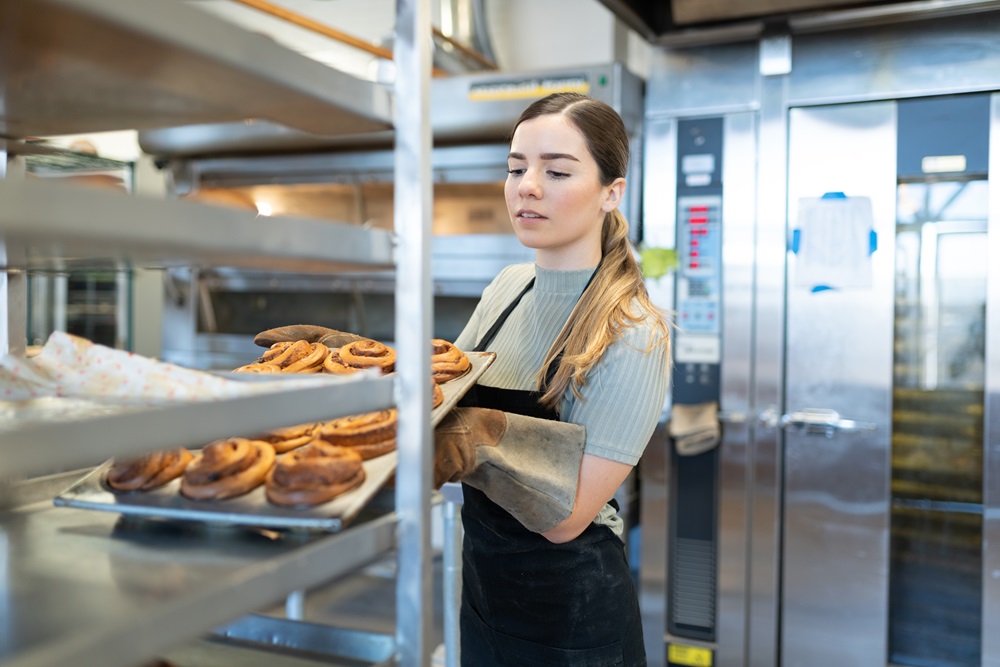- 1.Why You Must Implement Restaurant Food Safety Regulations
- 2.What Are the Main Components of Restaurant Food Safety
- 3.Restaurant Food Safety Tips for Success
- Be aware of all restaurant food safety laws in your area
- Provide constant training for your employees
- Uphold personal hygiene standards
- Take precautions with food allergens
- Purchase from approved suppliers
- 4.Restaurant Food Safety Checklist
- Restaurant premises
- Food preparation area design
- Equipment
- Water supply
- Food storage
- Food waste
- Pest control
- 5.Final Words
Did you know that 68% of foodborne illness outbreaks in the US occur at restaurants? Not having strict restaurant food safety regulations in place can lead to harm to your clients’ health, fines, and in some cases, closure.
Even a single negative review from a customer who was unhappy with your food safety can have a big negative effect on your business, deterring other people from visiting your restaurant.
If you want your restaurant to be successful long-term, you need to implement safe food handling practices and procedures. Check out this detailed guide on how to get your business up to code:
Why You Must Implement Restaurant Food Safety Regulations
Restaurant food safety is a must. The procedures should be settled before opening a restaurant and you have to put in constant effort to uphold them. Here are the risks and benefits of such regulations that will convince you to prioritize food safety:
If you don’t adhere to food and safety regulations, you risk:
- Food poisoning: the employees responsible for food preparation must know how food contamination happens and how to prevent it. Otherwise, clients can get seriously sick, and your food will be at fault;
- Loss of reputation: anyone who gets an adverse reaction to the food prepared at your restaurant will surely talk about it to their friends and will also leave negative reviews. When other potential customers learn about others’ unfortunate experiences, they will be discouraged from visiting your place;
- Penalty notices and closure: customers who got food poisoning at your restaurant might also complain to authorities. If you receive an inspection and they notice you are not up to code, you risk receiving penalties or even having your restaurant shut down for improper conditions.
If you put in the effort to get a high food hygiene rating, you will enjoy:
- Stress-free food safety inspections: if you ensure all food safety rules are respected every day, you won’t have to worry about surprise inspections. Because your kitchen is spotless and your ingredients stored properly, you will always pass with flying colors;
- An efficient operation in the kitchen: the food preparation will run smoothly if there are procedures in place for every step. Moreover, when every ingredient is labeled and stored properly, you will reduce food waste because everything will get used in the recommended period;
- Satisfied customers: clients notice even the smallest details in a restaurant. If you have a spotless kitchen and restaurant, customers will appreciate the safe environment and recommend your business. Furthermore, if you choose to cater to people with allergies, you will get even more clients.
What Are the Main Components of Restaurant Food Safety
To better understand a concept, it is best to break it into more manageable elements. Therefore, restaurant food safety is composed of the 4Cs:
- Cleaning: all parts of the restaurant and kitchen must be cleaned often and with attention to detail. Pay attention to often ignored elements such as kitchenware, bins, floors, and surface areas;
- Cooking: each ingredient served to clients must be cooked at the recommended temperature by food safety guidelines to ensure any harmful bacteria are eliminated;
- Chilling: all ingredients in the kitchen must be stored in closed containers that are labeled with the date when they were opened. They should also be kept in a temperature-controlled environment with a division by type. For example, raw meat can not be close to fresh produce;
- Cross-contamination: all employees should wear protective clothing and exercise personal hygiene to prevent the contamination of ingredients. Furthermore, if you cater to specific diets and allergens, you must have separate cooking utensils for each safe zone. You can color code them to ensure you remember what their purpose is.
Restaurant Food Safety Tips for Success
Check out these restaurant food safety tips that will help you get a food hygiene certificate that you use to let clients know that they will have a safe eating out experience at your place.
1. Be aware of all restaurant food safety laws in your area
Each country, state, and province will have laws in place regarding food safety in restaurants. With a quick Google search, you can ensure you abide by all of them.
You can also look up what the food safety inspectors are looking for in a perfect kitchen and how food safety management software can help, so you can prepare your business and get the highest rating possible.
2. Provide constant training for your employees
As your employees are the ones who will be constantly handling the food, they must know how to do it safely. Therefore, you must organize a restaurant food safety training and repeat it often to ensure everyone knows how to work with food safely and why it is important to stick to health regulations.
3. Uphold personal hygiene standards
The personal hygiene of employees should be addressed in the training, but the managers must also keep staff accountable. Because many rules are easy to forget, you can even create restaurant food safety posters with the following tips:
- Wash your hands before you handle and prepare food;
- Tie your hair back or protect it with a hat/hairnet;
- Keep your fingernails short with no varnish;
- Don’t wear jewelry as it can harbor bacteria;
- Do not wear strong fragrances that can interfere with the food;
- Wear protective clothing and wash it after each use;
- Do not eat or drink in the food preparation area.
Did you know that 40% of food poisoning outbreaks are caused by sick workers? To prevent employees from spreading their disease to fellow team members and customers, ensure you offer sick days and require valid medical certificates before allowing employees back into the workplace. Even the smallest cold can affect food preparation.
4. Take precautions with food allergens
Allergens are a chemical food hazard that is naturally occurring in some ingredients. The most common food allergens are eggs, fish, milk, peanuts, celery, mustard, tree nuts, sesame, shellfish, soybeans, cereals, and mollusks.
If people who are allergic to these ingredients are exposed to them, it can lead to an allergic reaction and even anaphylaxis.
It would be helpful for clients if you would add allergen information to your menu. This way, customers can just check the listed allergens for their desired dish and decide if it is safe for them to eat it.
With our menu creator, you can add information about allergens to all your menu items in just a few minutes and a few clicks.
5. Purchase from approved suppliers
You can respect all restaurant food safety regulations, but if you buy ingredients that are already contaminated, you risk giving your clients food poisoning. That’s why it is important to get your prime material from trustworthy sources:
- Only buy your ingredients from approved commercial suppliers;
- Ask for documentation to ensure they abide by the local laws;
- Carefully inspect each delivery and reject ingredients that are not up to standard.
Restaurant Food Safety Checklist
When you are creating your restaurant food safety plan, it will be helpful to take a look over this checklist to ensure you cover every important element.
1. Restaurant premises
All premises that are used to prepare and store food should have a regular cleaning program. You must clean regularly used surfaces at the end of each day and places like the freezer and refrigerator once a week.
It can also be helpful to provide adequate facilities for your employees to ensure they can stick to the food safety standards, such as:
- Separate staff changing space
- Toilets and handwashing facilities only for employees
- Ventilation in the kitchen and bathrooms
- Sufficient lighting in all spaces
2. Food preparation area design
Your local restaurant food safety legislation will provide specific requirements for the way you design and furnish your kitchen, such as:
- Floors must be made of a non-slip, yet easy-to-clean material
- Walls must be made of a durable, non-toxic, and easy-to-wash material
- Windows should have an insect screen
- Food preparation surfaces should be made out of a smooth, non-toxic, washable, and corrosion-resistant material
3. Equipment
All equipment in the kitchen must have a strict cleaning plan. You can’t afford to leave a mixer dirty until you need it two days later because it can become grounds for infection.
Make a schedule for your employees, so everyone knows when it is their responsibility to clean and what they should pay attention to.
4. Water supply
Not every building comes with tap water that is safe for consumption. But it is your responsibility, as a restaurant owner, to ensure that:
- All water used for cleaning, cooking, heating, cooling, or steaming food is of drinking quality
- Ice that goes in food or drinks is of drinking quality and is stored properly
- Water that is not drinking quality but is used for other purposes must be stored separately and never come in contact with the food
5. Food storage
A lot of cross-contamination in restaurants happens well before you prepare the food because of unfit ingredient storage. Here are a few tips that will help you ensure restaurant food safety:
- Wash raw ingredients before storing them
- Don’t use the same fridge for storing both prepared foods and raw ingredients
- Don’t overfill the fridge because it prevents ventilation
- Maintain cleanliness in the storage area
- Check the expiration date of ingredients often
- If using flowers for garnishes or presentations, be mindful of storing cut flowers in refrigerator to keep them fresh, but ensure they are kept separate from food items to avoid contamination
6. Food waste
The accumulation of food waste can both eat into your profit and also affect other still viable ingredients in your kitchen if you do not dispose of it immediately. Check out these tips for preventing food waste:
- Have separate bins for different types of waste
- Use bins with a foot pedal so employees don’t have to touch them
- Clean and disinfect bins regularly
- Have a separate area for bins and a strict schedule for emptying them
7. Pest control
Unfortunately, where there is food in large quantities, pests follow. A pest infestation can significantly impact your restaurant, so the best solution is prevention. Here is what you must do:
- Regularly check the restaurant premises for any spaces where pests may enter
- Keep the area around the restaurant clean and with no vegetation that could harbor pests
- Check deliveries for signs of pests
- Use a tight lid on bins to prevent pests from entering
- Use a pest control professional for food-safe preventive treatments
Final Words
Restaurant food safety can make or break your business. You only need a case of food poisoning for your reputation to be destroyed long-term.
It will be hard to get customers to trust you again after an incident, so it is best to do everything in your power to abide by food safety regulations.



